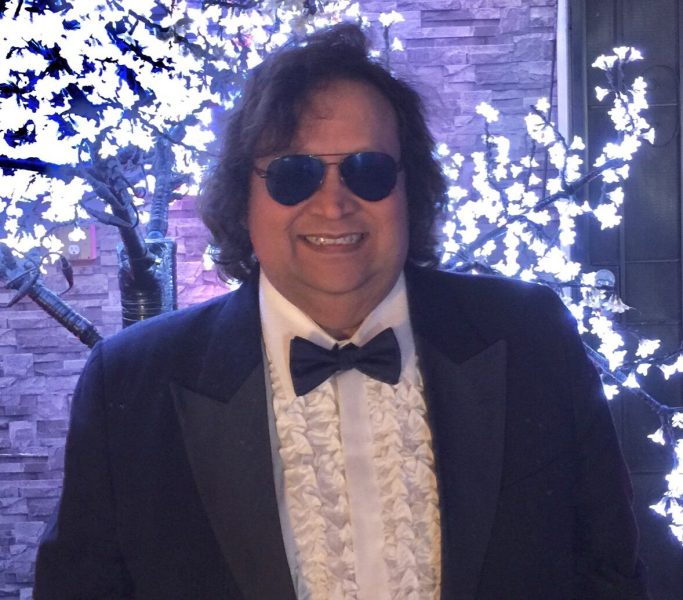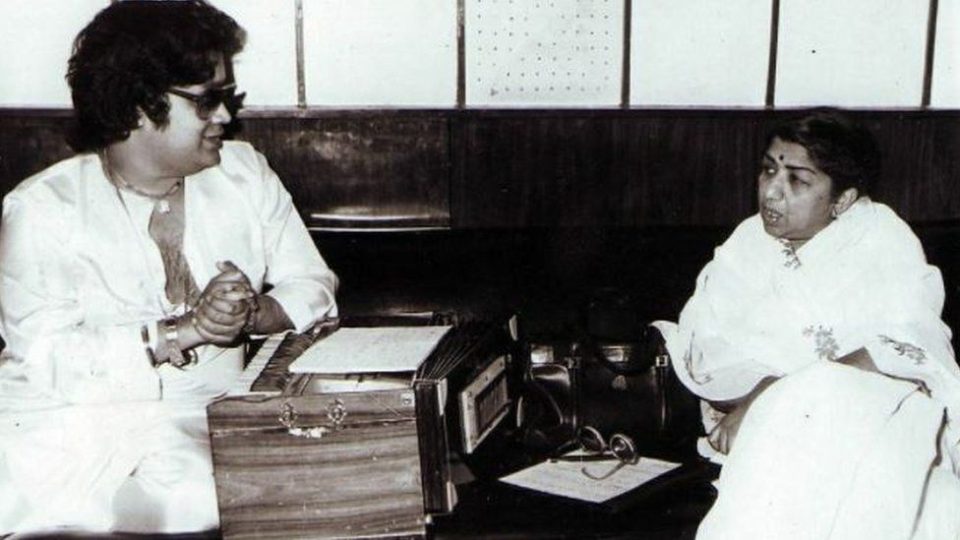
There was more to Bappi Da than disco and bling. Here’s why

If there was a John Travolta, a Boney M and a Michael Jackson in the ’80s, there was also the flamboyant, larger-than-life Indian music composer and singer, the ‘Dada’ of disco, Bappi Lahiri. It seemed amazing even back then that he had composed the melodious classic, the 1976 Chalte Chalte (which made even Kishore Kumar cry as he sang), and the peppy Pyar Mein Kabhie Kabhie from the same film, and also become synonymous for rambunctious, upbeat disco numbers such as Hari Om Hari, I Am A Disco Dancer and Rambha Ho Ho Ho.
That last song was sung by feisty playback singer Usha Uthup in all her concerts for more than 36 years. “Nothing works without this song,” she used to say.
The veteran singer and music composer, who died on Tuesday night, had given music for films for Dilip Kumar to Ranveer Singh. His repertoire was extensive. After all, he was just 19 years old when he began composing for films. Despite creating some iconic, hummable Hindi film melodies, the idiosyncratic musician is unfortunately linked mostly to his “groovy”, foot-tapping disco numbers.
And, he was known for wearing a lot of gold jewellery, and used to match traditional Indian kurta and sherwani with bindaas blazers and sweatshirts and topped off this trademark ensemble with a cool ‘Don’ style sunglasses. He was India’s original rockstar and he wanted the world to know it.
There was a reason, however, behind all the glittering gold jewellery that Bappi Da wore. But more on that later. First, it would be a shame to just dub him as the ‘Disco King’ of Hindi cinema. When asked why he was always associated with his disco numbers though he had some beautiful melodies to his name, Bappi Lahiri himself had no answer.
For example, in the 1975 Zakhmee, the film that shot Bappi Da to fame, he had numbers like the romantic song picturised on Rakesh Roshan and Reena Roy, Jalta Hai Jiya Mera Bheegi Bheegi Raaton Main. Take the melancholic, soulful Manzilen Apni Jagah Hain, or even the tuneful Inteha Ho Gayi, Intezaar Ki (His personal favourite) in Amitabh Bachchan’s 1984 Sharaabi.
In Mahesh Bhatt’s 1979 Lahu Ke Do Rang, he gave Chahiye Thoda Pyar, and also Zid Na Karo Ab To Ruko, which was rendered by none other than K J Jesudas. There was also a ghazal Bappi Da had composed for the movie Aitbaar, ‘Kisi nazar ko tera intezaar aaj bhi hain’ which became a huge hit. On the same note, Bappi Da himself has given the example of his popular hit number Saiyaan Bina Ghar Soona Soona from the 1979 Angan Ki Kali as an example of his melody numbers in Hindi films.
To Bappi Da, music was “zindagi mera gaana, main isi ka deewana” (life is my song, I am crazy about it). Music was his religion and his treasure, he has said. The singer composer, born in West Bengal as Alokesh Lahiri, was well-versed in classical music and Shyama Sangeet. His parents, who were classical singers, had trained him in every aspect of music.
After composing for a Bengali film, Daadu, in 1972, he tried his luck in the Hindi film industry reportedly with some help from his relative, the great Kishore Kumar. In 1979, he composed music for the Mithun Chakraborty starrer, Suraksha, and the song Mausam Hai Gaane Ka, which was influenced by the disco wave in the US, became a huge hit.
This set him on the “disco” track and along with lanky Mithun da, who could easily shake a leg, he ushered in a new wave of music to Bollywood with Disco Dancer, Dance Dance etc. In the ’90s, in Thanedaar, he composed and even sang the dance number Tamma Tamma Loge, picturised on Sunjay Dutt (an awkward dancer) and Madhuri Dixit. This song was so catchy that it was again remixed and used in the Varun Dhawan and Alia Bhatt starrer, the 2017 Badrinath Ki Dulhania.
Millennials remember Bappi Lahiri for the song Ooh La La (it was his comeback to the music industry and he was the singer not the composer) from the 2011 Dirty Picture, or the 2014 Tune Maari Entriyaan from 2014 Gunday. When he completed 50 years in the industry in 2019, Bappi Lahiri, whose gung-ho spirit was embodied in all his dance songs, was still going strong. He told PTI at the time that he never felt tired all these years. He had worked through thick and thin and felt happy that every year he still had a film song. He said: “Simply put, my life is Dilip Kumar to Ranveer Singh. From Dharm Adhikari to Gunday, I’ve done it all.”
Bappi Lahiri also had the record of composing 12 super hit silver jubilee movies starring Jeetendra as the hero between 1983-85. And he also held the record for most number of song recordings in a single day.
His Love for Gold Jewellery and Michael Jackson
When Bappi Lahiri was trying to make a mark in the Hindi film industry, there were giants like Shankar Jaikishen, Laxmikant Pyarelal, SD Burman, OP Nayyar and Kalyanji-Anandji around, which must have been daunting prospect for this young musician from Bengal. When Zakhmee became a big hit, his mother ostensibly gave him a ‘Hare Krishna Hare Ram’ gold chain to wear, which he considered his lucky charm. After his marriage, his wife gifted him a Ganpati chain and Lahiri, who was acutely aware of the fecklessness of fame, clung to these gold chains.
Bappi Da was also a huge Michael Jackson fan. And he got the opportunity to meet the late pop star when he came to Bombay in 1996 for a concert. Jackson was reportedly mesmerised by his gold jewellery, especially the Ganesha chain and even knew his song, Jimmy Jimmy from Zakhmee.
Bappi Da was always, however, dogged by allegations that he copied songs from the West. His popular Hari Om Hari, a number sung by Usha Uthup and picturised on Kalpana Iyer dancing in a den filled with young people smoking chillum, was allegedly a copy of One Way Ticket by Eruption. But in 2002, Bappi Da took an American rapper, Dr Dre, to court for copying his dance number Thoda Resham Lagta Hai, sung by Lata Mangeshkar and picturised on Aruna Irani. He accused the rapper of using the song in his album, Addictive, and won the case.

In the new millennium, Bappi Da went out of style. He recognised it wryly and often said that today it is all about hip-hop, Punjabi and Sufi songs. His album Bappi Magic – The Asli Baap Mix, featuring popular numbers such as Gori Hai Kalaiyan and Jimmy Jimmy, was released in 2004 with great fanfare. The following year he composed the background score for the Jahnu Barua film, Maine Gandhi Ko Nahin Maara, and lent his voice to the title track of the Mani Ratnam film Guru. The music was composed by AR Rahman, which also went on to become a super hit.
Interestingly, Lahiri’s most famous song, Jimmy Jimmy Ajaa Ajaa was featured in the Hollywood 2008 Adam Sandler film, You Don’t Mess with Zohan.
Bappi Lahiri, who sang duets with Mohammed Rafi and Kishore Kumar and worked with renowned singers like Lata Mangeshkar and Asha Bhosle, also played a role in launching singers like Sharon Prabhakar and Alisha Chinai. In 2016, the singer-composer, refusing to call it quits, even voiced the character of Tamatoa in the Hindi-dubbed version of Disney’s 3D computer-animated fantasy adventure film Moana. He, however, will always be remembered for the joy he gave Hindi film music lovers and even as people continue to link him to disco songs, it is tuneful numbers like Chalte Chalte mere ye geet yaad rakhna hai that remain timeless.

